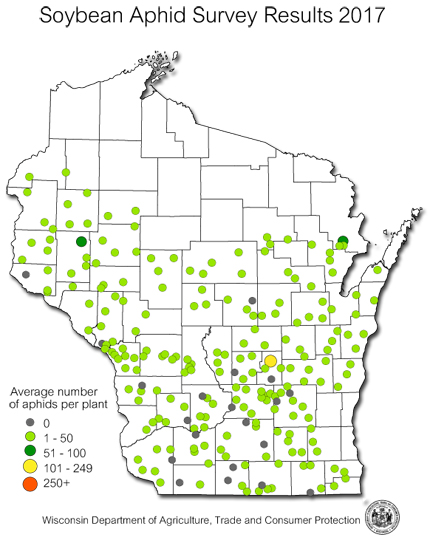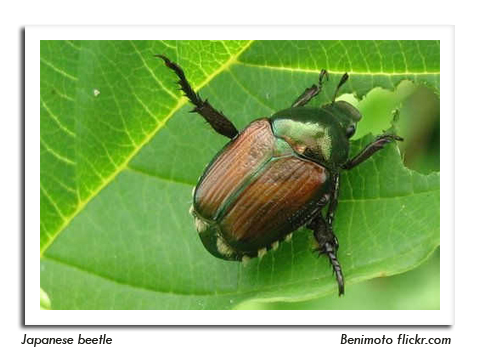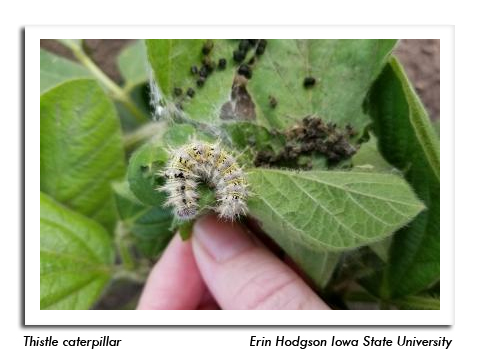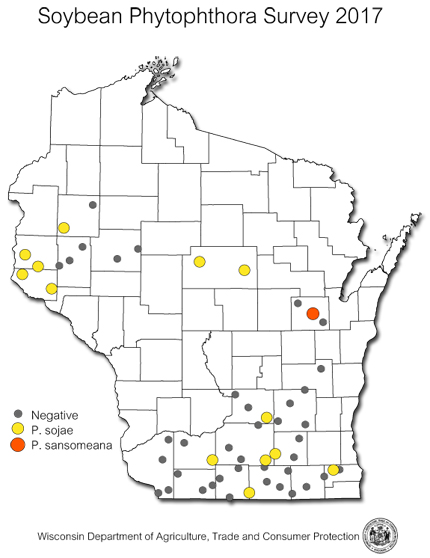
 |
|
|
Soybeans
Volume 62 Number 19 Date 11/09/2017 SOYBEAN APHID - Densities were the lowest since the first detection of soybean aphid in Wisconsin 17 years ago. The annual survey found a statewide average count of six aphids per plant, a slight decline from eight aphids per plant in 2016 and the lowest on record. Two hundred and twenty-eight soybean fields in the R2-R6 growth stages were sampled from late July through August. Aphid populations were below 50 aphids per plant in 96% of the fields and only 4% had moderate averages in the range of 51-100 per plant. A single Green Lake County field had the survey's highest average of 163 aphids per plant, while no fields sampled by DATCP had an above-threshold count of 250 per plant. Results of the survey confirm that aphid densities were low in most fields this season and insecticidal control was generally unwarranted. JAPANESE BEETLE - Defoliation was observed in about 87% of the fields examined in late July and August, indicating that Japanese beetle injury was more prevalent than ever in Wisconsin soybeans. Last season, 74% of sampled fields had some degree of feeding. Defoliation estimates were mostly below the 20% treatment threshold for reproductive soybeans, though chemical intervention was justified in some instances. Once primarily a fruit and landscape pest, the Japanese beetle has become a serious threat to Wisconsin's agronomic crops that soybean and corn growers must now factor into their pest management programs. SOYBEAN LEAFMINER - This red and black leaf mining beetle was collected by a DATCP specialist from La Crosse County soybeans on August 1. Although UW-Madison Insect Research Collection (IRC) records had documented finds in five other Wisconsin counties since 1975 (Dane, Grant, Rock, Sauk and Waukesha), the soybean leafminer had not previously been found on soybeans in the state. The species feeds on various legumes and most of the 15 IRC records were from tick trefoil. It is not known to cause direct economic damage but can transmit bean pod mottle virus and contribute to the spread of this pathogen in soybean fields. THISTLE CATERPILLAR - Larvae became common in soybeans during the first half of July and again around mid- to late August. A few exceptional cases of defoliation in excess of 20% were reported, but in most fields populations were not particularly large. Treatment was discouraged since the mortality rates generally are high and the solitary caterpillars seldom cause significant damage. The adult stage of this insect, the painted lady butterfly, was very common through mid-October. -- Krista Hamilton, DATCP Entomologist SOYBEAN ROOT ROT - Fifty-five soybean fields were surveyed for seedling root rot diseases from June 9-30. Molecular testing at the Plant Industry Lab confirmed Pythium in 96% of the fields, and Phytophthora sojae in 24%. The 2017 prevalence of P. sojae was a decline from 32% of fields in 2016 and 38% in 2015. Development of both Phytophthora and Pythium is favored by wet spring weather, though Pythium is active in cold, saturated soils, while Phytophthora is active in warm, intermittently wet soils. DATCP surveys in the last decade have found P. sojae prevalence ranging from 13% in 2011 to 49% in 2014. A second Phytophthora species, P. sansomeana, was also detected this season in an Outagamie County field. P. sansomeana was first identified in Wisconsin soybeans in 2012 and has now been documented in 10 counties: Calumet, Dane, Dodge, Dunn, Eau Claire, Green, Jefferson, Outagamie, Marathon and Sheboygan. -- Anette Phibbs, DATCP Plant Pathologist 





|
|
|